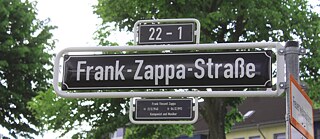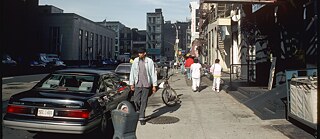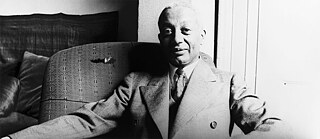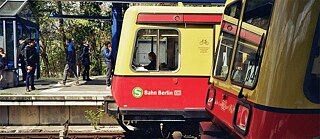Ungeahnte transatlantische Verbindungen
Street Names
Warum ist eine NS-Widerstandskämpferin in Brasilien berühmt, in Deutschland dagegen nahezu unbekannt? Wie wurde ein afro-amerikanischer Musiker in der ehemaligen DDR zum Nationalheld? Während Dina Elsayed nach Antworten auf diese Fragen sucht, stößt sie auf spannende Geschichten hinter ungewöhnlichen Straßennamen in Berlin.
Diese Folge anhören: Apple Music | Spotify | Download
Diese Folge zur Geschichte Berlins stammt aus der Feder von Soraya Nelson und Dina Elsayed. Soraya Nelson ist Journalistin Berlin und produzierte bis vor Kurzem als Programmdirektorin des Senders KCRW Berlin ein englischsprachiges Programm für Hörer*innen in der deutschen Hauptstadt. Sie stammt ursprünglich aus den USA und arbeitete 13 Jahre für den Sender NPR als Korrespondentin in Kabul, Kairo und Berlin. Dina Elsayed ist Redakteurin und Multimediaproduzentin aus Berlin. Sie begann ihre journalistische Laufbahn in 2012 als Produzentin für NPR in Kairo. Gemeinsam produzieren Soraya und Dina den wöchentlich erscheinenden, deutsch-amerikanischen Podcast Common Ground. Die Musik zu dieser Folge stammt von Paul Cantrell, Serge Quadrado, Till Paradiso, Matana Roberts, und Blue Dot Sessions. Außer dieser Episode, stammt von Soraya und Dina außerdem die Folge „Humor“.
Transkript
Dina Elsayed: What’s in a name? Or to be more precise, in a street name?
[STREET NOISES]
Dina Elsayed: We use them every day on applications, invitations, or other correspondence. We share them with family and friends, with officials, with taxi drivers. But street names are more than a simple address.
[SOFT MUSIC]
Dina Elsayed: They tell us stories about people, places, and time. They can inspire or sadden or sometimes anger.
Woman 1: It’s triggering in a very good way. And that was amazing for me, and I was like, oh wow, you know, and I could connect.
Woman 2: So, it’s a little jarring then, I think to see it in Berlin and to think that it’s being celebrated is also, honestly, irritating.
Dina Elsayed: Their responses are to street names in my city, which was once divided and struggling with its identity. While the wall in Berlin is long gone, street names still denote the demarcation. You can often tell whether you are in the former East or West by looking at the width of the letters on the signs. Even the punctuation here is by design.
Beata Gontarczyk-Krampe: So in Berlin, there are strict rules, and one of the rules says that if the place is named after a person, if it’s a surname, then you write the name of the street with the co-joined “Strasse” or “Platz” as one word.
Dina Elsayed: That’s Berlin author, blogger, and wanderer Beata Gontarczyk-Krampe.
Beata Gontarczyk-Krampe: So for example, “Schleiermacherstrasse” is spelled as one word. And then, you look at “Senefelderplatz,” and you see it’s like one word. But there’s also a place called Senefeld. This is how you actually recognize, so you know that Senefelderplatz was named after Alois Senefelder because it’s spelled as one word. And if you go to Feuerbachstrasse, then you also see whether it’s a place called Feuerbach or whether it’s a person. It’s a person because it’s spelled as one word.
Dina Elsayed: Gontarczyk-Krampe, who hails from Poland, says her obsession with street names in the German capital began 14 years ago after the birth of her eldest son.
Beata Gontarczyk-Krampe: Which means that you go for long walks during the day, pushing the pram. And that’s exactly what I did. And then, when you have time and you have to sort of spend time moving around, you start noticing things that you would probably normally not pay attention to because you would be in a hurry. So, I wasn’t in a hurry, and I started paying attention to things like, for example, gaps in the street. Like there was a building missing, so why is the building missing? And I paid attention to the street names as well.
Dina Elsayed: Her blog, “Kreuzberged — Berlin Companion,” unlocks the secrets of those signs and more.
Beata Gontarczyk-Krampe: I had two more children, twins in the meantime, so there was even more pram pushing. Yeah, and I discovered wonderful things about Berlin. And it’s like a permanent rabbit hole for me.
Dina Elsayed: For her, the street names in her former neighborhood of Kreuzberg serve as a bridge to the past.
Beata Gontarczyk-Krampe: The area around the Victoria Park, the streets were — they have something to do with the wars of liberation, so wars against Napoleon — a big, big thing in Prussian history. And so, you have those streets like Großbeerenstrasse, Katzbachstrasse, and so on and so on, and Mehringdamm used to be called Belle-Alliance-Strasse, which I think is the most beautiful name. [LAUGHS] I have a particular sort of fondness for the Belle-Alliance-Strasse.
Dina Elsayed: “Belle Alliance,” or “The Beautiful Alliance,” is how the Prussians came to describe the Battle of Waterloo, which saw the final defeat of Napoleon in 1815.
[CLASSICAL MUSIC]
Dina Elsayed: Some Berlin streets harken back to European composers like the Componisten Viertel in the Berlin suburb of Weissensee, where Chopinstrasse, Puccinistrasse, and Mahlerstrasse intersect.
[CLASSICAL MUSIC]
Dina Elsayed: Other streets have a more fruity significance like in the district of Marzahn before it joined Berlin a century ago.
Beata Gontarczyk-Krampe: Marzahn was a village, and the village was almost completely depopulated after the Thirty Years’ War, so people were invited to come. There were Huguenots coming from France, for example, and in this case, they came from Kurpfalz, and they were gardeners, and they set up flourishing gardens. And they introduced a lot of new apple sorts because they brought the seeds with them. So, in order to honor those people, when the new Siedlung — when the residential estate high-rises were built — they named the streets after the names of the apple.
Dina Elsayed: There are also many streets in Berlin that highlight the city’s strong, transatlantic link. Like Frank-Zappa-Strasse, named for the American rocker. Or Jesse-Owens-Allee, named for the American gold medalist who is credited with crushing Adolf Hitler’s claims of Aryan supremacy.
[STREET NOISE]
Dina Elsayed: One short street in Berlin reaches as far as Brazil.
[STREET NOISE]
Dina Elsayed: Located in the neighborhood of Prenzlauer Berg, it’s only 180 meters or 590 feet long and was named for Olga Benário Prestes a half-century ago. The Munich-born Nazi resistance fighter fell in love with Brazilian communist leader Luís Carlos Prestes and moved with him to Brazil in 1934.
[SAD MUSIC]
Dina Elsayed: When an attempted coup a year later, led by her lover, failed, she was deported back to Nazi Germany. Prestes was eventually murdered in a Nazi gas chamber.
[SAD MUSIC]
Dina Elsayed: Many Germans may not have heard about Prestes, but she is famous in Brazil.
[BRAZILIAN MUSIC]
Dina Elsayed: Thais Nepomuceno is a Brazilian filmmaker from Rio de Janeiro. She lives in Berlin.
Thais Nepomuceno: Olga was one of these women that always appeared in our, you know, lectures, telling oh, how she fought against dictators, governments, how she was important for our society, to fight against authoritarian governments. So when I was a child, she was this image of this fighter.
Dina Elsayed: I first learned about Prestes when Nepomuceno came to visit me. She had trouble finding my apartment, which led to a surprising find.
Thais Nepomuceno: I was walking towards your house. The streets are all the same, and the buildings looks like the same. And I look like, I think this is the building. And then, you told me the number, and I was at the number and was like it doesn’t look like, you know, because the door was not like this and I was like — because when I get lost, like, going somewhere, I get very distressed. And I was like, ah. [SIGH]
Dina Elsayed: She went to look for the street name and saw it was Prestes’s name. Nepomuceno’s jaw dropped.
Thais Nepomuceno: Wow! There's a street for her here! And then, my distress went away because I was amazed that, at the same time, I was like oh, I’m lost, I found her street. I felt relieved because oh, finally, you know, I’m seeing something from her. And also something that I can connect, and I know who is this person, and probably people that lives in the street doesn’t know her, it is just the name of the street for them. But like for me, oh, I know the story. I know her. And then, I was like, okay, that’s cool. And I felt like, okay, now I’m fine. [LAUGHS]
Dina Elsayed: Brazilian artist Tatiana Heide is another Prestes fan who is happy to find a Berlin street named for her German-born heroine.
[CAFE NOISE]
Dina Elsayed: I meet Heide across town in the Neukölln district.
Tatiana Heide: So, we are in this vegan cafe, just beside the house that Olga Benário lived with Otto Braun in her first moment when she arrived in Berlin. In the neighborhood that, at the time, was called The Red Fort, which was the communist neighborhood, the workers’ neighborhood.
Dina Elsayed: Heide says Prestes’s story gave her a sense of belonging from the moment she moved here from São Paulo, more than seven years ago.
Tatiana Heide: I was two weeks in Germany walking, just pushing the stroller in the streets with a baby and like dealing with my new life, and I saw a poster of this docu-theater play. There was this call for people to take part in a theater project.
Dina Elsayed: Heide hit it off with the director, and they brainstormed on what her role in the play would be.
Tatiana Heide: She realized that Olga, who has lived in Brazil, would be our link and that I could tell the story of Olga inside the play to the Germans — not playing Olga, but telling her story and bringing her up in the play.
Dina Elsayed: The performance took place in a small theater called Heimathafen, a few blocks from where Prestes once lived. The play told the stories of Jewish families who lived there. Their furniture was stowed in the theater after the Nazis moved them to concentration camps. Heide says she identifies closely with Prestes.
Tatiana Heide: I was the same age as Olga was at the time when she was imprisoned. She had a baby like I did, so it was a very strong bond to this character that actually was in the book and in the story. But I felt her very alive, and I felt it was like, okay, so that’s why I’m here. Let’s tell her story, and I really got that as my mission for me. It still is, I really feel connected to her, and it’s part of my biography here, it’s to bring her story up, yeah.
Dina Elsayed: But the fact few Germans appear to know who Prestes is, surprised Heide.
Tatiana Heide: So when I was sharing her story on stage, and I started asking: Have you ever heard of Olga Benário? Was really depressing because, like I would say, ten percent of the audience would raise their hands.
[BRAZILIAN MUSIC]
Dina Elsayed: Nepumoceno agrees that Prestes is far better known in Brazil. There are multiple films and telenovelas about her there. Many of the scenes have become memes, used in Brazilian chat groups.
Thais Nepomuceno: It was so interesting because back in time before Facebook we have this meme of her. It’s like: I’m pregnant of Luís Carlos Prestes, and I want to have my baby in Brazil. So, it’s a scene in the film that she came to the journalist press, and she say out loud: I’m pregnant, and I want to have my baby here. So, we started to reproduce this image like, I’m pregnant. I want to have my baby here! But not like mocking her, but more like this powerful things, like speaking out loud, like: Hey, I want to do this. And she spoke out, she was very verbal.
[STREET NOISE]
Dina Elsayed: Back in Berlin, there’s a leafy residential street in Pankow named for a bass-baritone who was born in New Jersey in 1898.
[JAZZ MUSIC]
Dina Elsayed: His name is Paul Robeson, and he was a Black entertainer, singer, activist, and polymath embraced by the communist German Democratic Republic.
Kira Thurman: He had studied mathematics. He had studied at Rutgers University, Columbia, also played football. He was really this figure, such a dynamic figure, who was such a vibrant and larger-than-life personality.
Dina Elsayed: Kira Thurman is an assistant professor of history and German studies at the University of Michigan in Ann Arbor. Her first book is on the history of Black musicians in Germany and Austria in the 19th and 20th centuries. I visit her in Munich to learn why Robeson made it big in the former East Germany, where xenophobia abounded, in part because racism there was never officially acknowledged and addressed.
Kira Thurman: One of the reasons why Paul Robeson became so well known was for singing pieces like “Old Man River” from the musical “Showboat.” It was, I think, really his most famous song, the song that he was the most known for, that he kept getting requested to sing. But Paul Robeson was also famous for being a committed Marxist and committed socialist. And that really stemmed from his upbringing and his identity as a Black man in America. He came to believe pretty firmly by the 1920s, 1930s, in socialism and in Marxism as a means of Black liberation and Black civil rights in the United States. So, that’s really the context that I think is most important for people to understand when thinking about who Paul Robeson was and what his international legacy was.
[JAZZ MUSIC]
Dina Elsayed: Robeson’s music was popular in the former GDR, as were his politics. The thing is, Robeson never lived in the GDR. He only visited East Germany twice: in 1960, when he received an honorary doctorate from Humboldt University, and again in 1963, to receive medical treatment.
Kira Thurman: The irony here is that Paul Robeson and Eslanda Robeson had been to Germany before, but they had arrived in Germany in 1934 after Hitler had come to power, and it had been such a terrible experience for them that they stayed less than 24 hours in Berlin before fleeing to Moscow. So, Paul Robeson was familiar with German-speaking Europe and with Germany in particular. And then after World War II, he had made some connections to communist circles in Eastern Europe. And really it’s through these connections, through different figures, like in the Culture Ministry in the GDR and the like that he received this invitation to come to the GDR, where I should say he received an honorary degree and a peace medal as well for his contributions to international human rights from their perspective.
Dina Elsayed: There is more to Robeson’s complex legacy than his socialism, however.
Kira Thurman: I think that Paul Robeson lives on in a lot of African American activism today as well, that eventually, as people do their history and do their digging, they do come across Paul Robeson as one of these important figures who was willing to speak the truth about American racism and about the problems that Black people faced in such a vital and critical way.
Dina Elsayed: Thurman says many Americans — especially white ones — can’t get past their discomfort with his embracing Marxism and socialism.
Kira Thurman: Nonetheless, he believed throughout his lifetime really that the solutions to the problems of institutional racism in the United States depended on creating a more equal society, and that he thought that was possible by embracing socialism, basically.
Todd Carmody: Now, I think his legacy is really dominated by his politics, his turn to the left. And so, he lent his voice, as it were, so both literally and figuratively, to the socialist, internationalist cause.
Dina Elsayed: Todd Carmody is a cultural and literary historian who first heard about Robeson during a visit to Berlin 22 years ago. I reached him in New York.
Todd Carmody: His records sold incredibly well, I understand, in East Germany. There was a lot of infatuation with the music, and there’s a lot of overlap between sort of the socialist propagandizing of his career, but also just people loved his music. And so, I think somewhere in between there, it’s how we understand. So, this legacy in East Germany that folks really liked what he was doing, his recordings, and then, they were being encouraged to like his performances and his politics by the state.
[MATANA ROBERTS MUSIC]
Dina Elsayed: Sound experimentalist and jazz saxophonist Matana Roberts sees Robeson not just as an artist with a strong hold overseas, but as an outspoken fighter for racial equality. I reached them in Chicago.
Matana Roberts: It was interesting to be reminded of the history of that power. Like I look at Paul Robeson as a giant like he was and will forever remain a giant.
[END MUSIC]
Matana Roberts: I don’t care how many different ways people try to take down his contributions based on, you know, some political decisions that he made without having all the full information. And yet, people try to use that against him still to this day.
Dina Elsayed: Roberts says they see themself in Robeson.
Matana Roberts: Being the son of an escaped slave — who dared to still speak up for injustices — I recognize, oh yeah, I come from exactly similar stock, where I was taught not to be quiet, and it’s gotten me in trouble. It continues to get me in trouble. [LAUGHS] I do not feel that I have yet been able to do it at the level of the Robesons, but I look to them as a standard. I often say that I stand on the backs of many people who never got a chance to express themselves. And I’m pretty certain that the Robesons felt similar at a different time.
[EXPERIMENTAL MUSIC]
Dina Elsayed: He became a force in Roberts’s life when they were still young.
Matana Roberts: One of the pieces I used to focus on as an alto saxophonist was “Motherless Child,” the spiritual that Paul Robeson was also quite known for. But I also grew up in a household with extended family. My grandmother had season tickets to the Chicago Lyric Opera, and at the time as a child, I had a very hard time with it, going to the opera. It was very difficult for me, but it also set the pace of understanding different art forms. And as I continued to study music, I have a background in classical music and also jazz, but my formal training was in classical music. You cannot not come across Paul Robeson.
Dina Elsayed: Robeson was inducted into the East Germany Academy of Arts as an affiliate member in 1960. Five years later, East Berlin’s Academy of the Arts established the Paul Robeson Archive in his honor. Carmody points out it isn’t your typical archive.
Todd Carmody: While the archive in East Berlin tried to get as much material as they could, and they did get some very valuable original materials, they were also really worried about Paul Robeson’s legacy and about material being destroyed in the United States that they couldn’t get their hands on. And I think it’s hard for us to imagine, but these were really legitimate concerns, given just how he was under surveillance by the FBI. The CIA had taken away his passport. And so, the archive is also filled with lots of photocopies of materials held elsewhere. And so, there’s a real kind of effort to just make sure to safeguard, to get everything. And so, in my own work, I’ve theorized that it’s kind of being an archive of absence, in the same way that Robeson was kind of an absent figure in East German popular culture, that they kind of wanted him to come visit. He couldn’t come visit. And he was known for his telephone recordings, telephone concerts, all of this sort of disembodied presence that he had. I think you see a resonance with that in the archives itself.
Dina Elsayed: Decades later, Robeson’s legacy in Germany and the United States is still a difficult one because of his connection to the communist East. Thurman explains our awareness of him is muted as a result.
Kira Thurman: I find it really interesting that for all of the celebrations in 1960 for Paul Robeson, that we nonetheless today don’t really remember him as much. That, yes, there’s a street, Paul-Robeson-Strasse, but that somehow people walking by it don’t know who he is. I wonder if a part of that has to do with, of course, the nature of the Wende of 1989 through 1991, that period of transition — of creating a Federal Republic of Germany — and how much, whatever was East German and whatever got celebrated as East German got erased, to a certain extent. So, it’s really interesting to me that he is one of the only Black figures that has an archive collection named after him in Germany. He’s one of the only figures that has a street named after him. But nonetheless, today, we don’t really know or understand what he did and who he was.
[JAZZ MUSIC]
Dina Elsayed: Roberts, however, sees signs of him everywhere. That one just needs to look deeper.
Matana Roberts: It’s an amazing experience to walk through certain parts of Berlin and see “Black Lives Matter” signs. That has been a moment for me where I’m like, yes, this is part of the legacy of the Robesons in a sense, of making sure that we understand our global connections. And I see through the “Black Lives Matter” movement in the U.S., an understanding of that as well like the old saying: We can’t all be free if some of us are not free, you know. And I’ve been to the Paul Robeson Street in Berlin and also just been like, oh, wow! Right! I still don’t feel that they’re being remembered fully as they should in either place, and I hope to add to changing that a bit.
Dina Elsayed: Not all Berlin street names are embraced, however.
[SUBWAY NOISE]
Dina Elsayed: Like this Berlin subway stop, which at first glance appears linked to the controversial novel by Harriet Beecher Stowe. The stop is called Onkel Toms Hütte, or hut. It is located on Onkel Tom Street, which was named in 1933. There, you will also find Onkel Toms Burgers, and the Onkel Toms Hütte daycare center.
Kira Thurman: I think there’s actually a pretty good bakery there [LAUGHS] is what I would say.
Dina Elsayed: But Thurman quickly turns serious.
Kira Thurman: Yeah, it feels so archaic to a certain extent and definitely outdated, you know, and the context behind it is that “Uncle Toms Hütte,” or “Uncle Tom’s Cabin,” was a popular abolitionist novel in the 1850s, and I believe in 1852, it was the number one international bestseller in Germany as well, that people would stage plays of “Uncle Toms Hütte” in Germany. But even though the novel was really popular, it still was really problematic in its portrayal of Black people and that basically the critique over time has been that not only are the Black characters in it overly simplified, but even worse: They’re willing to sacrifice themselves — like Uncle Tom — for the sake of their white slave masters.
Dina Elsayed: Thurman says that lesson seems to be lost on Berlin.
Kira Thurman: So, it’s a little jarring then, I think, to see it in Berlin, and to think that it’s being celebrated is also honestly irritating.
Dina Elsayed: But Gontarczyk-Krampe says anger over that street name may be misplaced.
Beata Gontarczyk-Krampe: Onkel Toms Hütte actually has very little to do with the book as such, at least as far as I know, because you can always have different opinions. There would be people who would find a closer link between the two. But Uncle Tom’s Hütte is actually a “Siedlung,” which is like a residential estate, in Zehlendorf, and there used to be indeed a place. It was not so much an “Eckkneipe,” as a kind of an inn. And it was opened on the edge of the “Grunewald,” of the forest. And it was a place, which was basically established for people going horse riding, and the owner of this place was called Thomas. And Herr Thomas, he built kind of huts, so that his guests could be sort of sheltered from the rain and to make the place a little cozier, so to say. And the place was not called Uncle Tom’s Hütte. He didn’t call it that. Those were his guests who gave the place that name.
Dina Elsayed: She says she did read that he was a big fan of the book but adds that even if the street and subway station are named after him and not the book, it doesn’t mean they shouldn’t be changed.
Beata Gontarczyk-Krampe: I read an article in “Die Zeit,” and one point I was not aware of was that how offensive really the name is to some people of color. And at the same time, how strong the argument of the other side is that this was not meant as an offensive name. I think the first time that this term was used officially as an offensive term was when Malcolm X referred to Martin Luther King.
Dina Elsayed: When I ask the professor, Kira Thurman, who she would like to see a street named after, she mentions Bayume Mohamed Husen. You haven’t heard of him? Here’s a clue.
[SAD MUSIC]
Dina Elsayed: In the center of Berlin, there’s a “Stolperstein,” or “stumbling stone” engraved with his name. There are more than 75,000 of the brass-plated squares across Germany. They are embedded in sidewalks and streets to memorialize victims of the Nazis. Thurman says he is one of only three Black people with a Stolperstein.
Kira Thurman: So, Mohamed Husen was an Afro-German entertainer and figure who had fought during World War I on behalf of the German Empire. His family came originally from German East Africa, and then, he had settled in Berlin in the 1920s and 1930s. With the rise of the Nazis in 1933, he, like so many other Afro-Germans, struggled to find work, struggled to find ways to live and be safe and protected. So, he took on all kinds of odd jobs, including performing in the “Deutsche Afrika Schau” in 1936 — the “German Africa Show” — which really, sort of, in its terrible kind of exotic, racist way, put Africans on display for white Germans to look at. Following this, even following all of his petitions to the German Colonial Office for help, he was sent to a concentration camp, to Sachsenhausen in particular, where he died. He, I think, is an example of somebody who lived his life in Germany, fought hard for freedom and to be recognized as German, and was persecuted for it. So, I think there’s this longer history of Black Germans in general that we should be aware of and that I think could be made visible on the streets in Berlin.
Dina Elsayed: Naming or renaming streets here turns out to be a fairly straightforward process, despite Berlin’s intractable bureaucracy, Gontarczyk-Krampe says.
Beata Gontarczyk-Krampe: So, the boroughs can decide which names they want to see, you know, on the street signs. And the initiative comes from the people. Anyone can start a petition.
Dina Elsayed: That sounds good in theory. But in practice, it’s harder. Case in point: An online petition running for more than two years, and signed by nearly 15,000 people, demanding Onkel-Toms-Hütte Street [sic] and subway station be renamed. There are still no plans to do so.
[SOMBER MUSIC]
Dina Elsayed: It took years of protest by anti-colonial campaigners for Berlin to agree to change the name of “Mohrenstrasse,” or “Moor Street.” It will be renamed Anton-Wilhelm-Amo after Germany’s first Black philosopher.
[MUSIC]
Soraya Nelson: That was Dina Elsayed with “Street Names.” Frederic Chopin’s “Prelude Opus 28, No. 9” was performed by Paul Cantrell. Also featured are “Brazil” by Serge Quadrado, “Woke up this Morning” by Till Paradiso, and “All is Written” by Matana Roberts from their album “Coin Coin Chapter Three.” And from Blue Dot Studios, we heard “Nine Count,” “Minister Creek,” “Vulcan Street,” and “Ervira.”







